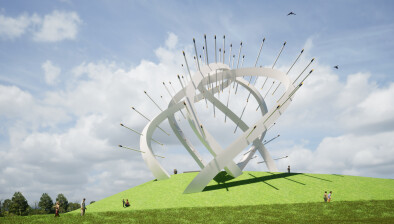And finally… Norwegian tower to take title of world’s tallest wooden building
 When completed in March 2019, Mjøsa Tower in the Norwegian town of Brumunddal will be the world’s tallest wooden building.
When completed in March 2019, Mjøsa Tower in the Norwegian town of Brumunddal will be the world’s tallest wooden building.
The building will stand over 80 metres tall and its 18 storeys will house offices, a hotel and apartments.
Rune Abrahamsen, managing director of Moelven Limtre AS, a general subcontractor in the Mjøsa Tower project, said the construction, which started in early April this year, is an example of how wood can be substituted for concrete, which is considerably heavier and less environmentally friendly.
According to Abrahamsen, wooden buildings are the solution to the high demand for new housing and offices, urban densification, and stringent environmental demands. Using wood as the main building material produces lightweight and cost-effective buildings that are quick to build and have minimal environmental impact. This also applies to load-bearing elements.
Wood is an environmentally friendly building material. As a raw material, it is renewable and abundantly available in the Nordic countries. The material absorbs more carbon dioxide as the tree grows than the quantities emitted in the manufacture of this construction material. The wood’s light weight means less transportation and lighter foundations of the kind required for concrete buildings.
Using wood as the main construction material, even in high-rises, is key to shortening the construction time and, consequentially, cost. Modern technology enables us to prefabricate all components in a factory with a very high degree of precision. Compared to cast-in-situ concrete, wood makes it possible for construction time to be slashed by half. In addition, it’s relatively easy to make adjustments or corrections on-site.
Abrahamsen said: “The floor structures, which consist of massive beams with Kerto panels on top, are assembled in our factory, just 15 kilometres from the construction site. Obviously, that’s a huge advantage if you have something that needs to be adjusted at the factory. The work is progressing at the rate of one storey a week, which has shortened our construction time by approximately 35 to 40 per cent compared to using cast-in-situ concrete. And since the wooden components are so lightweight, we don’t need the machinery to be as heavy.”
Fire safety is not a weak point in the wooden Mjøsa Tower. Untreated solid wood creates its own fire-resistant surface because the outermost layer chars when exposed to fire, protecting against further fire damage.
In fact, wood is a fireproof material despite the commonly held belief that it isn’t.
“Fire safety rules state that buildings must be able to withstand a full fire for at least two hours without collapsing. When you have a building made of steel and concrete, the steel melts and the building collapses,” said Erik Tveit, project manager at HENT AS, the general contractor for the site.
Nevertheless, concrete will be used between the floors of the Tower’s top seven storeys. Using concrete has nothing to do with the load-bearing capacity. There’s a simpler explanation: the swaying that increases the higher you get in a building built of wood or concrete. The weight of the concrete in the upper storeys makes the swaying slower and not as readily perceivable.














